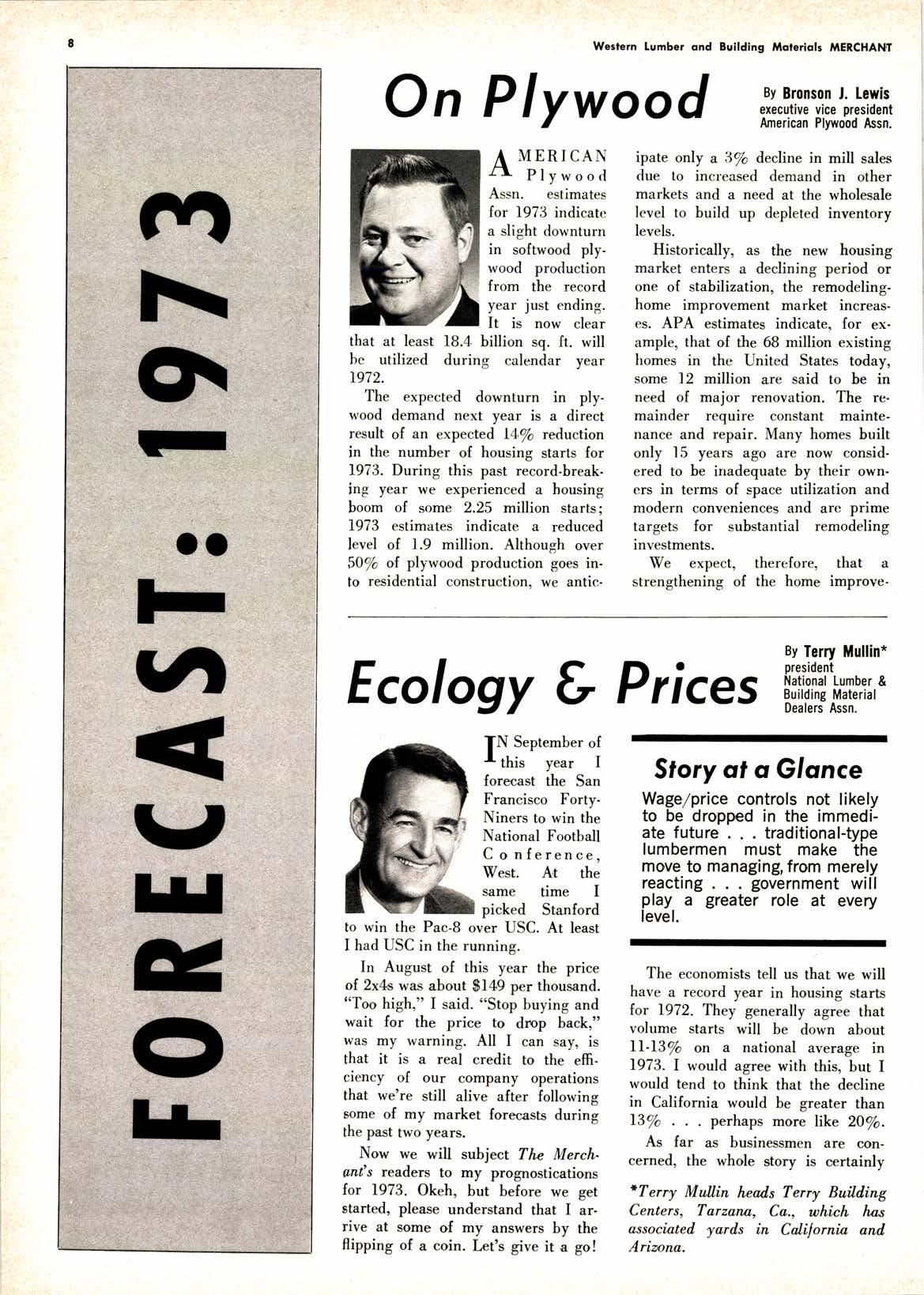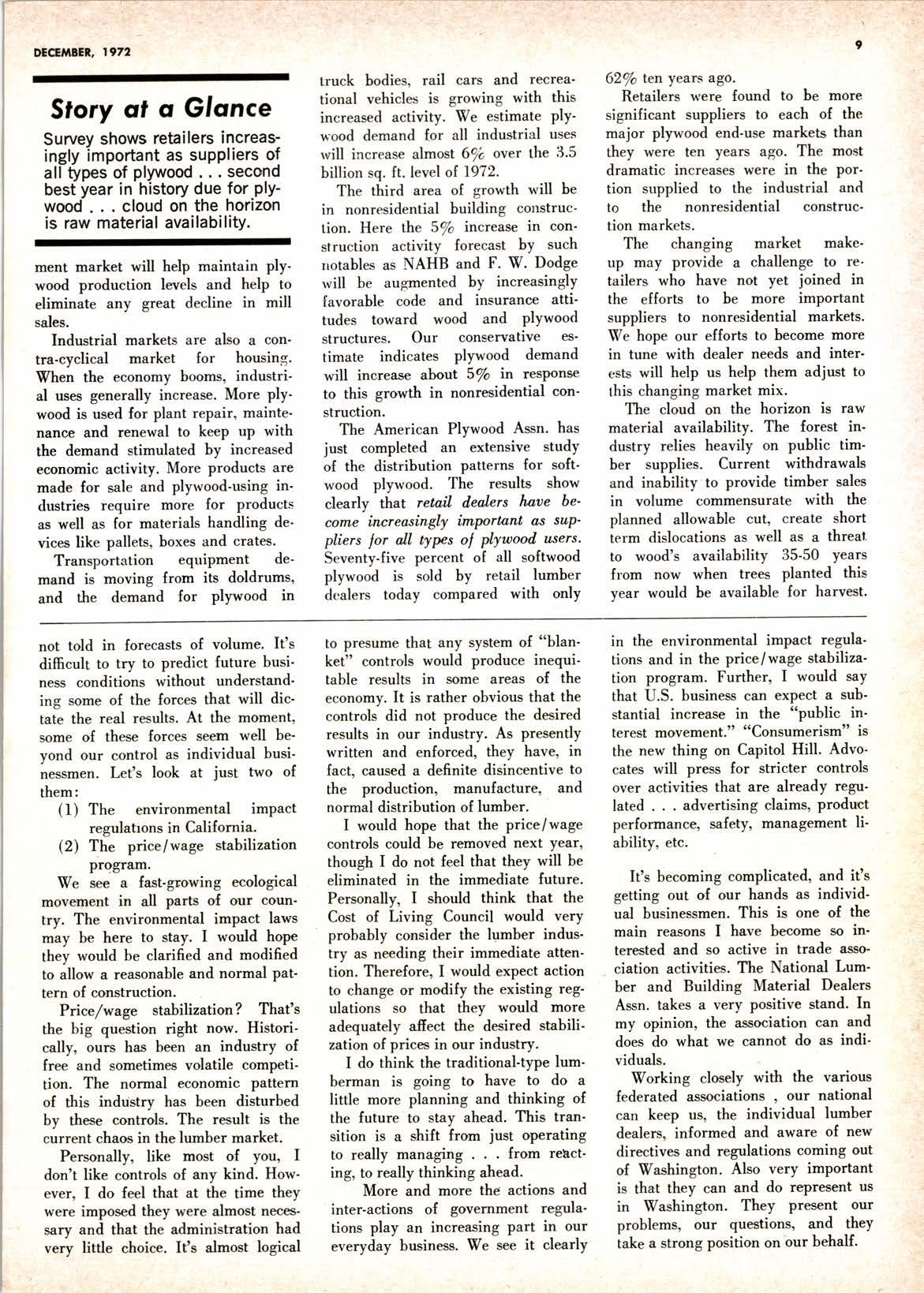
5 minute read
Ecology t, Prices
fN September of r this vear I forecast the San Francisco FortyNiners to win the National Football C o nference, West. At the same time I picked Stanford to win the Pac-8 over USC. At least I had USC in the running.
In August of this year the price of 2x4s was about $149 per thousand. t'Too high," I said. "Stop buying and wait for the price to drop back," was my warning. AII I can say, is that it is a real eredit to the efficiency of our company operations that we're still alive after following some of my market forecasts during the past two years.
Now we will subject TIrc Merchonf's readers to my prognostications for 1973. Okeh, but before we get started, please understand that I ar. rive at some of my answers by the flipping of a coin. Let's give it a go!
WageTprice controls not likely to be dropped in the immediate future . . . traditional-type lumbermen must make the move to managing, from merely reacting . . government will play a greater role at every level.
The economists tell us that we will have a record year in housing starts Ior 1972. They generally agree that volume starts will be down about ll-13% on a national average in 1973. I would agree with this, but I would tend to think that the decline in California would be greater than 13% . . perhaps more like 2O/o.
As far as businessmen are concerned, the whole story is certainly
*Terry Mullin heads Terry Buikling Centers, Tarzana, Ca., which lrr.s associated yards in Colilornia and, Arinna.
Slory al s Glonce
Survey shows retailers increasingly important as supPliers of all=types of plywood second best lear in history due for PIYwood . . cloud on the horizon is raw material availability.
ment market will help maintain plywood production levels and help to eliminate any great decline in mill sales.
Industrial markets are also a con. tra-cyclical market for housing. When the economy booms, industri' al uses generally increase. More ply' wood is used for plant repair, mainte' nance and renewal to keep up with the demand stimulated by increased economic activity. More products are made for sale and plyrvood'using in' dustries require more for product-" as well as for materials handling de' vices like pallets, boxes and crates.
Transportation equiPment demand is moving from its doldrums, and the demand for plYwood in not told in forecasts of volume. It's difficult to try to predict future busi' ness conditions without understand' ing some of the forces that will dic' tate the real results. At the moment, some of these forces seem well be' yond our control as individual busi' nessmen. Let's look at just two of them:
(I) The environmental impact regulatrons in California.
(2) The price/wage stabilization pro.gram.
We see a fast-growing ecological rnovement in all parts crf orr coun' try. The environmental impact laws may be here to stay. I would hoPe they would be clarified and modified to allow a reasonable and normal pat' tern of construction.
Pice/wage stabilization? That's the big question right now. Histori' cally, ours has been an industry of free and sometimes volatile competition. The normal economic Pattern of this indristry has been disturbed by these controls. The result is the current chaos in the lumber market.
Personally, like most of you, I don't like controls of any kind. How' ever, I do feel that at the time they were imposed they were almost necessary and that the administration had very little choice. It's almost logical truck bodies, rail cars and recrea' tional vehicle; is growing with this increased activity. We estimate ply' wood demand for all industrial uses rvill increase almost 6Jb over the 3.5 billion sq. ft. level o11972.
The third area of growth u'ill be in nonresidential building colrstruc' tion. Here the 5/o increase in con' struction activity forecast by such rrotables as NAHB and F. W. Dodge will be augmented bY increasinglY favorable code and insurance atti' tudes toward wood and PlYwood structures. Our conservative es' timate indicates PlYwood demand will increase about 5/o in response to this growth in nonresidential con' struction.
The American Plywood Assn. has just completed an extensive studY of the distribution patterns for soft' wood plywood. The results show clearly that retail ileal,ers lwnte be' come increasingly hnpornnt as suPpliers lor all typs ol plywood users. Seventy-five percent of all softwood plywood is sold by retail lumber dealers today compared with only to presume that any system of "blan' ket" controls would produce inequitable results in some areas of the economy. It is rather obvious that the controls did not produce the desired results in our industry. As presently written and enforced, they have, in fact. caused a definite disincentive to the production, manufacture, md normal distribution of lumber.

I would hope that the price/wage controls could be removed next year' though I do not feel that they will be eliminated in the immediate future. Personally, I should think that the Cost of Living Council would very probably consider the lumber indus' try as needing their immediate attention. Therefore, I would expect action to change or modify the existing reg' ulations so that they would more adequately a.fiect the desired stabilization of prices in our industry.
I do think the traditional-type lum' berman is going to have to do a little more planning and thinking of the future to stay ahead. This tran' sition is a shift fro,m just operating to really managing . from rebct' ing, to really thinking ahead.
More and more the actions and inter-actions of government regula' tions play an increasing part in our everyday business. We see it clearly in the environmental impa.ct regula' tions and in the price/wage stabiliza' tion program. Further, I would saY that U.S. business can expect a sub. stantial increase in the "public in' terest movement." ttConsumerism" is the new thing on Capitol Hill. Advocates will press for stricter controls over activities that are already regulated . advertising claims, product performancg safety, management li' ability, etc.
62/o ten years ago.
Retailers were found to be more significant suppliers to each of the major plywood end-use markets than they were ten years ago. The most dramatic increases were in the portion supplied to the industrial and to the nonresidential construction markets.
The changing market makeup may provide a challenge to retailers who have not yet joined in the efforts to be more important suppliers to nonresidential markets. We hope our efforts to become more in tune with dealer needs and inter. esls will help us help them adjust to this changing market mix.
The cloud on the horizon is raw material availability. The forest industry relies heavily on public tim' ber supplies. Current withdrawals and inability to provide timber sales in volume commensurate with the planned allowable cut, create short term dislocations as well as a threat' to wood's availability 35-50 years flom now when trees planted this year would be available for harvest.
It's becoming complicated, and it's getting out of our hands as individ' ual businessmen. This is one of the main reasons I heve become so in' terested and so active in trade association activities. The National Lum' ber and Building Material Dealers Assn. takes a very positive stand. In my opinion, the association can and does do what we cannot do as indi' viduals.
Working closely with the various federated associations , our national can keep us, the individual lumber dealers, informed and aware of new directives and regulations coming out of Washington. Also very important is that they can and do rePresent us in Washington. They present our problems, our questions' and theY take a strong position on bur behalf.










